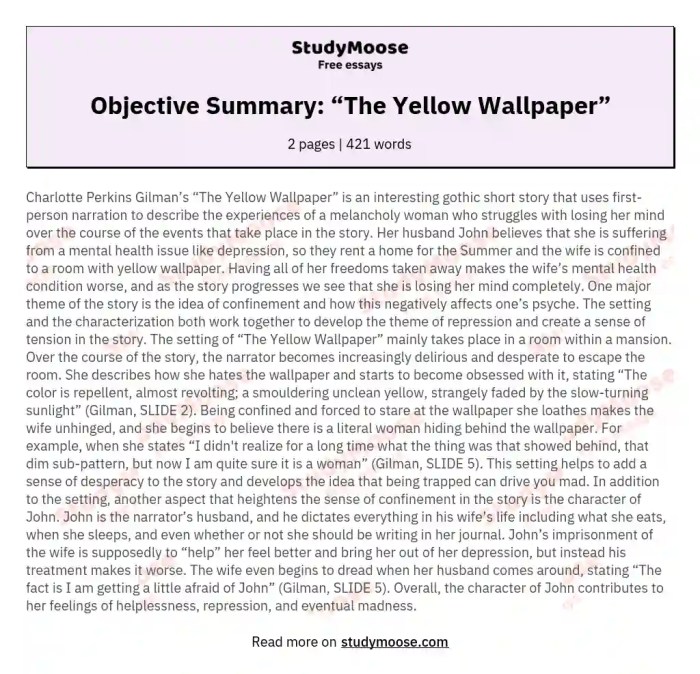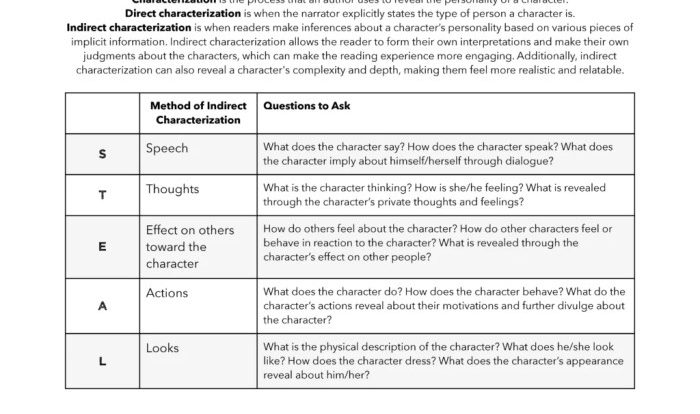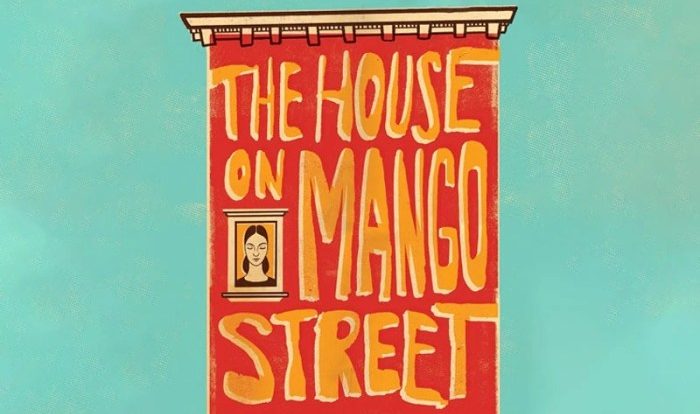The Yellow Wallpaper Character Analysis Essay delves into the intricacies of a captivating narrative, examining the complex psychological state of the narrator and the profound impact of her confinement within a restrictive environment.
Through a meticulous exploration of the story’s symbolism, gender dynamics, and Gothic elements, this essay unravels the narrator’s deteriorating mental health and the oppressive forces that shape her identity.
Character Analysis of the Narrator
The narrator of “The Yellow Wallpaper” is a complex and enigmatic character whose psychological state unravels throughout the story. She is a young woman suffering from what her physician husband dismisses as “temporary nervous depression.” As her confinement to the room progresses, her mental health deteriorates, and she experiences vivid hallucinations and delusions.
Deteriorating Mental Health
- She becomes obsessed with the yellow wallpaper in her room, seeing hidden patterns and figures within it.
- She develops a sense of paranoia, believing that her husband and sister are conspiring against her.
- She experiences auditory hallucinations, hearing whispers and strange noises.
Symbolism of Confinement
The narrator’s confinement to the room symbolizes her oppression and powerlessness. She is isolated from the outside world, denied any meaningful activity or connection with others. This confinement exacerbates her mental illness, driving her further into isolation and madness.
The Wallpaper as a Metaphor
Symbolism of the Yellow Wallpaper
The yellow wallpaper in the narrator’s room is a powerful metaphor for her inner turmoil. Its garish color and intricate pattern represent her own complex and fragmented mental state. The wallpaper’s hidden patterns, which the narrator becomes obsessed with, symbolize her subconscious desires and fears.
Reflection of Inner Turmoil
The narrator’s changing perceptions of the wallpaper mirror her deteriorating mental health. Initially, she finds the wallpaper ugly and oppressive, but as her illness progresses, she begins to see it as a source of comfort and companionship. This reflects her growing disconnection from reality and her retreat into her own inner world.
Significance of Hidden Pattern
The hidden pattern within the wallpaper represents the narrator’s own hidden desires and fears. As she becomes increasingly obsessed with the pattern, she is actually confronting her own repressed thoughts and emotions. The pattern’s elusive nature symbolizes the narrator’s struggle to understand and control her own subconscious.
Gender and Identity

Role of Gender in Oppression
The narrator’s gender plays a significant role in her oppression. As a woman in the Victorian era, she is expected to be submissive and subservient to her husband. Her husband’s dismissal of her illness and his insistence on her confinement to the room reflect the societal expectations of women at the time.
Relationship with Husband
The narrator’s relationship with her husband is characterized by control and domination. He dismisses her concerns, forbids her from working or pursuing her own interests, and isolates her from the outside world. This relationship stifles her individuality and exacerbates her mental illness.
Female Agency and Self-Expression
The narrator’s struggle for agency and self-expression is central to the story. Her confinement and isolation prevent her from fulfilling her creative and intellectual potential. The yellow wallpaper becomes a symbol of her desire for freedom and self-expression.
Gothic Elements
Gothic Atmosphere
“The Yellow Wallpaper” employs several Gothic elements to create an atmosphere of suspense and horror. The setting of an isolated and eerie mansion, the use of darkness and isolation, and the supernatural elements all contribute to the story’s haunting and oppressive atmosphere.
Darkness and Isolation
The narrator’s confinement to the room and her isolation from the outside world create a sense of claustrophobia and dread. The darkness of the room and the lack of natural light further contribute to the oppressive atmosphere.
Supernatural Elements
The narrator’s hallucinations and delusions, such as her belief that she is being watched by unseen figures, introduce supernatural elements into the story. These elements add to the sense of mystery and suspense, blurring the line between reality and madness.
Symbolism of Objects
Bars on Windows, The yellow wallpaper character analysis essay
The bars on the windows symbolize the narrator’s entrapment and powerlessness. They represent the societal and patriarchal forces that confine and oppress her.
Rocking Chair
The rocking chair is a symbol of the narrator’s mental instability. Her incessant rocking back and forth represents her inability to find peace or escape from her troubled mind.
Bed
The bed is a symbol of the narrator’s physical and mental confinement. She is forced to remain in bed, unable to move or act freely. This symbolizes her lack of control over her own life and her own body.
Color and Texture
The use of color and texture in the story is significant. The yellow wallpaper, with its garish color and intricate pattern, represents the narrator’s mental chaos and fragmentation. The darkness of the room and the cold, damp texture of the walls reflect her feelings of isolation and oppression.
Themes of Oppression and Isolation

Forms of Oppression
The narrator experiences multiple forms of oppression in the story. She is oppressed by her husband, by societal expectations, and by her own mental illness. These forces combine to create an environment of isolation and powerlessness.
Relationships and Confinement
The narrator’s relationships with her husband and sister contribute to her isolation and oppression. Her husband’s controlling nature and her sister’s lack of understanding further isolate her and exacerbate her mental illness.
Societal Expectations
Societal expectations for women in the Victorian era also contribute to the narrator’s oppression. She is expected to be submissive and subservient, which stifles her individuality and prevents her from pursuing her own interests.
User Queries: The Yellow Wallpaper Character Analysis Essay
What is the significance of the yellow wallpaper in the story?
The yellow wallpaper serves as a potent symbol of the narrator’s deteriorating mental state, reflecting her feelings of entrapment, isolation, and the gradual erosion of her sanity.
How does the narrator’s relationship with her husband contribute to her oppression?
The narrator’s husband, John, embodies the patriarchal society that oppresses her. His dismissive attitude towards her illness and his insistence on controlling her life further exacerbate her feelings of isolation and powerlessness.
What are the key Gothic elements present in the story?
The story incorporates Gothic elements such as darkness, isolation, and the supernatural to create an atmosphere of suspense and horror, reflecting the narrator’s psychological turmoil and the oppressive nature of her confinement.


